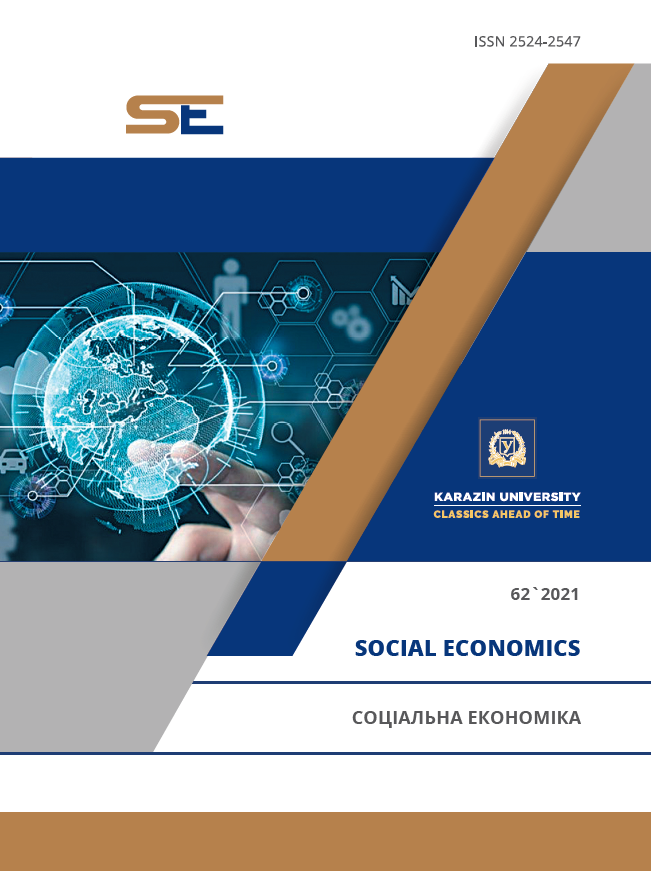COOPERATION BETWEEN THE HR- AND THE MARKETING DEPARTMENTS
Abstract
The purpose of the work is to identify the main ways of cooperation between the HR-department and the marketing department and to develop recommendations for improving the efficiency of the company, which will be based on such cooperation. We identified the processes and methods of enterprise management that actively use marketing in their own practice. We investigated theoretical approaches and practical directions of definition of ways of cooperation of human resources and marketing departments. These issues focused on increase of economic efficiency of the enterprise from the work with recruiters, personnel, and consumers.
We determined that HR-management and marketing have gone beyond their competencies. The large number of international firms is a clear example of effective cooperation between these two departments. It is important to understand that the brand has a direct impact on both customers and candidates. In this case, there is an urgent need for cooperation between the human resources department and marketers to increase the efficiency of hiring and retaining existing employees.
In today’s world, effective HR-marketing is much more than just attractive job postings or caring about a good work environment. The highest goal of HR-marketing is to increase the attractiveness of the company as an employer. This means that the company intends to positively distinguish itself as a brand from the competition, i.e., HR-marketing is strongly associated with the term branding of employers. Its manifestations are best seen in all activities related to the management of the company’s personnel - from the recruitment and selection stage to the care of employees associated with the company, and the support of high-potential people in the organization. This requires long-term consistent action. However, the benefits of well-established staff marketing heavily outweigh the costs of implementing it.
The way to transform new employees of the company into professionals who can increase the efficiency of its work, as the attraction of previous experience as customers, and its transformation through meeting customer demand.
Downloads
References
Bacon, N., Wright, M., Demina, N., Bruining, H., & Boselie, P. (2008). The effects of private equity and buy-outs on HRM in the UK and the Netherlands. Human Relations, 61(10), 1399-1433. doi: https://doi.org/10.1177/0018726708095709.
Bieda, M. (2021). HR Marketing. Wiedza HR. Retrieved from https://pl.softgarden.io/resources/glossary/hr-marketing/.
Chang, E. (2005). Employees’ overall perception of HRM effectiveness. Human Relations, 58(4), 523-544. doi: https://doi.org/10.1177/0018726705055037.
Colombo, E. (2015). Why Marketing and HR need to work together on the employer branding strategy. Blu Ivy Group. Retrieved from https://bluivygroup.com/why-marketing-and-hr-need-to-work-together-on-the-employer-branding-strategy/.
Deloitte. (2014). Global Human Capital Trends 2014. Engaging the 21st century workforce. Retrieved from http://www2.deloitte.com/sa/en/pages/human-capital/articles/human-capital-trends-2014.html.
Galang, M., & Ferris, G. (1997). Human Resource Department Power and Influence Through Symbolic Action. Human Relations, 50(11), 1403-1426. doi: https://doi.org/10.1177/001872679705001104.
Gratton, L. (2013). Rise of Employer Brand Research. Hot Spots Movement.
Grimshaw, D., & Miozzo, M. (2009). New human resource management practices in knowledge-intensive business services firms: The case of outsourcing with staff transfer. Human Relations, 62(10), 1521-1550. doi: https://doi.org/10.1177/0018726709336498.
Hyde, P., Harris, C., & Boaden, R. (2009). Human relations management, expectations and healthcare: A qualitative study. Human Relations, 62(5), 701-725. doi: https://doi.org/10.1177/0018726709103455.
Lipman, A. (2019). The Relationship Between Marketing & Human Resources. Teamgate. Retrieved from https://www.teamgate.com/blog/marketing-and-human-resources-relationship/.
Luna-Arocas, R., & Morley, M. J. (2015). Talent management, talent mindset competency and job performance: The mediating role of job satisfaction. European Journal of International Management, 9(1), 28-51.
Marchington, M., & Wilkinson, A. (2008). Human Resource Management at Work. London, CIPD.
Marchington, M. (2008). Where Next for HRM? Rediscovering the Heart and Soul of People Management. IES Working Paper, Institute of Employment Studies, Brighton.
Martinsons, M., & Chong, P. (1999). The Influence of Human Factors and Specialist Involvement on Information Systems Success. Human Relations, 52(1), 123-152. doi: https://doi.org/10.1177/001872679905200107.
Miira. (2017). Why HR and marketing should work together. TalentAdore. Retrieved from https://talentadore.com/why-hr-and-marketing-should-work-together/.
Plomion, B. (2019). How Marketing And HR Can (And Should) Work Together. Forbes. Retrieved from https://www.forbes.com/sites/forbescommunicationscouncil,/2019/11/26/how-marketing-and-hr-can-and-should-work-together/?sh=28ddd3611758.
Rajalakshmi, A., & Srinivasan, J. (2017). Role of HR in marketing: (A Review). International Journal of Latest Trends in Engineering and Technology, 8(1), 090-096. doi: http://dx.doi.org/10.21172/1.81.012.
Reinhart, C. (2019). The Relationship Between Marketing & Human Resources. Chron. Retrieved from https://smallbusiness.chron.com/relationship-between-marketing-human-resources-10287.html.
Thatcher, M. (2017) HR and Marketing: Bringing Both Together for Better Business. Business 2 community. Retrieved from https://www.business2community.com/human-resources/hr-marketing-bringing-together-better-business-01845846#:~:text= HR%20and%20marketing%20are%20working,of%20the%20company%20to%20employees.
Ulrich, D., Allen, J., Brockbank, W., Younger, J., & Nyman, M. (2009). HR Transformation: Building Human Resources from the Outside In. New York: McGraw Hill.
Wright, C. (2008). Reinventing human resource management: Business partners, internal consultants and professionalization. Human Relations, 61(8), 1063–1086.
Wright, P., Stewart, M., & Moore, O. (2011). The 2011 CHRO Challenge: Building Organizational, Functional and Personal Talent. Centre for Advanced Human Resource Studies, Cornell University ILR School, Ithaca.
Mykhaylova, A. (2020). HR-marketing: what it is and why it is needed. Retrieved from https://hurma.work/blog/hr-marketing-shho-cze-ta-navishho-vin-potriben/. (in Ukrainian)




